New Treasures: Image Firsts Compendium, Volume One
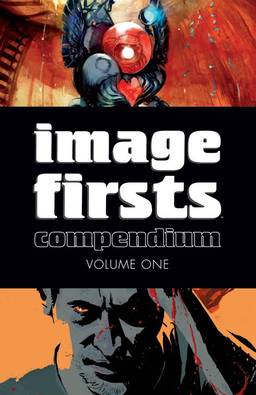 There’s a lot of good work going on in comics. Correction: there’s a lot of great work going on in comics, especially if you’re a fantasy fan.
There’s a lot of good work going on in comics. Correction: there’s a lot of great work going on in comics, especially if you’re a fantasy fan.
It’s hard to keep up with it all. However, I’ve developed a simple system over the years. Once a month I visit my local comic shop here in St. Charles (Graham Cracker Comics; and here’s a shout out to Dan W. and Kurt Biallas, who’ve been selling me terrific comics since Kurt was about ten years old), and buy the first few issues of anything that looks interesting.
I take them home and give them to my 19-year-old son Timothy, whom I’ve studiously trained in the art of comics — starting by reading the entire Lee-Ditko run on Amazing Spider-man to him and his younger brother Drew when they were both still in footie jammies. Timothy patiently reads these comics cover-to-cover, and lets me know which ones are worth my time.
Everyone should have a 19 year-old son like Timothy. He’s also handy when the lawn needs to be mowed, or the driveway needs to be shoveled.
Sadly, Timothy made an unfortunate life choice last year (unfortunate for me, anyway). He went off to college in another state. The stack of comics waiting to be read now fills nearly an entire box, and it’s gathering dust in the corner, neglected. Clearly, I need a new system.
Apparently I’m not the only person to have this problem. When I was in the comic shop last month, I found Image Firsts Compendium, Volume One propped up near the cash register. It’s a fat, 320-page full cover graphic novel, containing the first issues of no less than nine new titles from Image Comics. And it’s priced at $5.99 — less than it will cost you for two measly comics.
I shouldn’t have to point out this is an incredible bargain. Already I like this new system better than my old one. I shelled out my $5.99, brought it home, and settled in to find out what’s new at Image.
What’s new is a lot of excellent horror, drama, fantasy, and science fiction by some of the industry’s top writers and artists. Not every story was a winner, but I did discover several worth following — and three that sent me back to the comic shop immediately, ready to buy whatever other issues were available.
The book contains the first issues of the following ongoing series:
Wytches by Scott Snyder and Jock
Outcast by Kirkman & Azaceta by Robert Kirkman and Paul Azaceta
Nailbiter by Joshua Williamson and Mike Henderson
Southern Bastards by Jason Aaron and Jason Latour
The Fade Out by Ed Brubaker and Sean Phillips
The Wicked + The Divine by Kieron Gillen and Jamie McKelvie
Low by Rick Remender and Greg Tocchini
Shutter by Joe Keatinge and Leila del Duca
C.O.W.L. by Kyle Higgins, Alec Siegel, and Rod Reis
Here’s a closer look at each one. [Click on any of the images for bigger versions.]
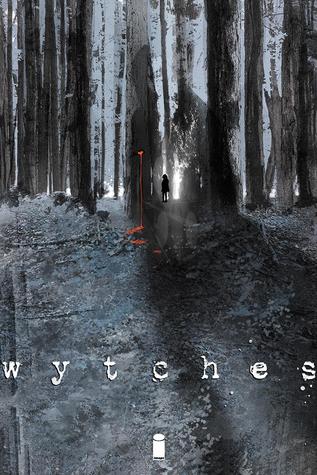 |
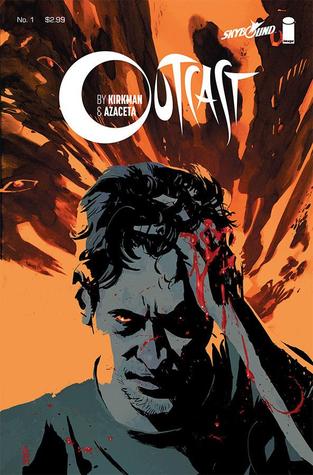 |
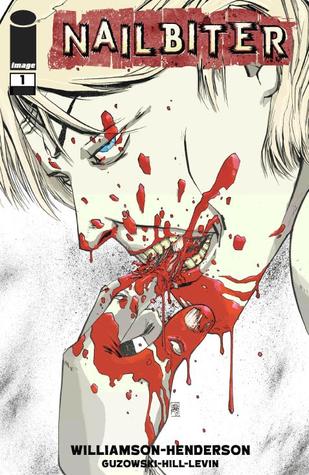 |
Wytches is a well-written tale of a family whose young daughter Sailor witnessed the brutal and mysterious death of a bully, Annie. Sailor, who is prone to anxiety, is starting over in a new school — where everyone believes she killed Annie in self defense. As she tries to get to sleep after a very trying day, Sailor hears her name… and sees a twisted creature who looks very much like Annie outside her window. By the time her parents react to her screams and reach her room, Sailor is gone. In an afterword, author Scott Snyder pens a terrific essay about hunting for witches in the woods behind his house with his boyhood friend Ryan, and how the strange things they saw influenced Wytches.
Wytches is fun and creepy, but it’s not nearly as creepy as Kirkman and Azaceta’s Outcast, the tale of Kyle Barnes, a shattered and aimless young man who lives in squalor. Kyle’s mother was possessed by a demon and she locked him in a food pantry… and his wife Allison was possessed years later. When Kyle is drafted to help a local minister with the exorcism of a young boy — a boy who knows entirely too much about what happened to both Allison and his mother — Kyle suddenly starts to put things together, and realize that dark forces have been stalking him his entire life, and he needs to find out why. Robert Kirkman is the writer and co-creator of The Walking Dead, and one of the most acclaimed comic writers on the market, and with Outcast, he brings his A-game.
I was entertained by both Wytches and Outcast, but Nailbiter was the first comic in this collection to grab my attention immediately and not let go. The tiny town of Buckaroo, Oregon has produced sixteen of the worst serial killers in the country’s history. Army Intelligence Office Nicholas Finch is seriously contemplating suicide when he gets a call from an old friend, detective Eliot Carrroll. Carrroll tells him that he’s finally cracked the secret of the Buckaroo Butchers… but he needs his help. By the time Finch makes it to Buckaroo the next morning, Carrroll has vanished… leaving behind some tantalizing clues that put Finch squarely in the path of the one serial killer to be acquitted on a technicality… the notorious Edward Charles Warren, known as the Nailbiter.
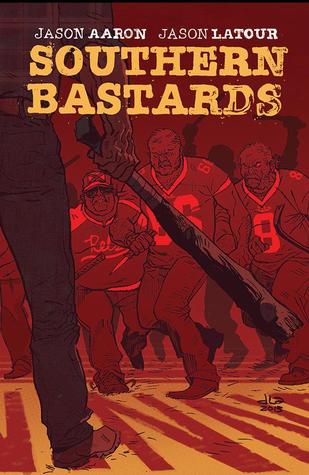 |
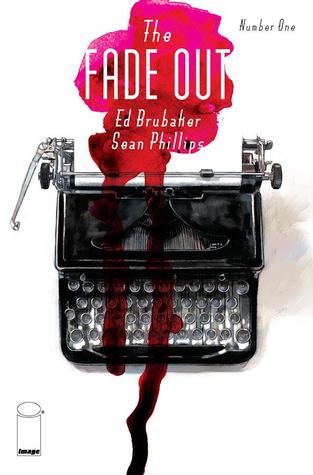 |
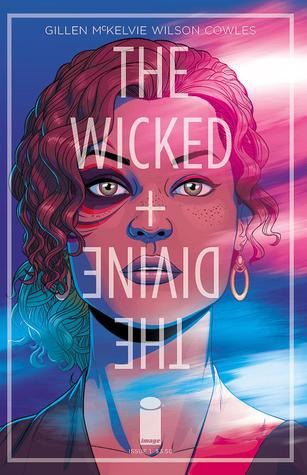 |
Southern Bastards was flat-out excellent. Earl Tubb returns to Craw County, four years after leaving as a football star, to sort out his ailing Uncle’s affairs. In his Uncle’s home he finds pictures and mementos of his famous father’s years as town sheriff. In town Earl encounters Dusty Tutwiler, who’s run afoul of some local toughs. When Dusty is about to come to a bad end in the back room of the Boss BBQ restaurant, the 58-year old Earl uses a deep fryer to make short work of Dusty’s tormentor, Esaw Goings, and casually tosses Esaw’s gun into the boiling oil. Warning him that he’s meddled in affairs far beyond his understanding, Dusty runs off. Jason Latour’s artwork is as clean and as captivating as any comic art I’ve even seen, and Jason Aaron’s script is virtually perfect. I came to this one highly skeptical, and became a convert almost immediately. I want to read the rest, and I want it now.
Ed Brubaker and Sean Phillips’ The Fade Out is another outstanding issue. Charlie Parish is a troubled screenwriter in post-war L.A. He wakes up in the bathtub after a particularly wide party involving some of Hollywood’s more famous and most notorious stars… and on his way out, he stumbles over the body of Valeria Sommers, the beautiful young star of the film Charlie is working on. Grabbing a rag in the darkness, he erases any evidence he can find that he and his friends were there, and runs. Not until 12 hours later, in the office of the cold and calculating Phil Brodsky, the Studio’s head of security, does Charlie discover that someone returned to the scene of the crime and arranged Valeria’s body to make it look like a suicide. Charlie is the only one to know his friend was murdered… and he starts recruiting people to do something about it. All the smoking frankly made me a little nauseous — it seems like someone is lighting a cigarette on every single page — but otherwise I found it a compelling and thoroughly engaging mystery.
Kieron Gillen and Jamie McKelvie’s The Wicked + The Divine has a catchy premise — seventeen year-old girls surrendering most of their fated years to live two glorious years as a literal goddesses, with the power of life and death over mortals — but I found it a bit too enigmatic for my taste. McKelvie’s art is also very sparse, especially when bracketed by Sean Phillips’ gritty detail in The Fade Out and the lush excess of Greg Tocchini’s Low — but everything is easy to follow, and his faces are nicely expressive. The Wicked + The Divine ends with a shocking murder in a courtroom, and one of the beautiful goddesses being hustled into custody as she loudly proclaims her innocence. Intriguing and original, but just shy of the non-stop inventiveness of the other titles in this collection.
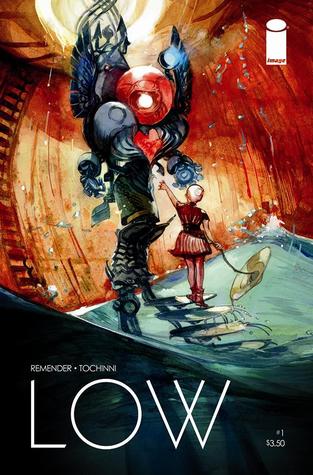 |
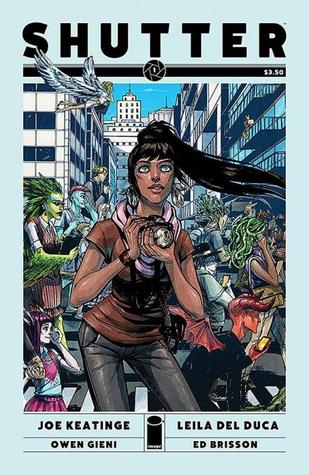 |
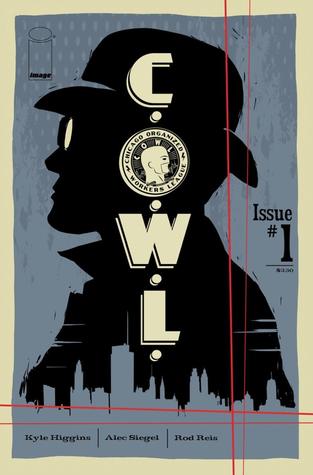 |
Speaking of non-stop inventiveness, that’s a pretty fair description of Rick Remender and Greg Tocchini’s Low, a far future underwater epic of the Caine family, the only humans coded with the genetic sequence that allows them to use the near-legendary Helm Suit of Salus. Don’t ask me what the Helm Suit does — we never get to find out. The Caine family’s ship, bare minutes after it launches on the first training mission for the two young heirs, Della and Tajo, is lured into a trap by a mammoth squid and boarded by the creature’s allies, the Scurvy Horde. Remender and Tocchini have created a marvelous and enigmatic world filled with giant talking squids, domed cities, a humanity on the brink of doom, thousand-year-old space probes, and much, much more. Only a fraction of it all is remotely explained, but somehow the story never seemed to move slowly or lose my interest.
I wish I could say the same about Shutter, which reminds me in some ways of Mike Carey and Peter Gross’s Vertigo comic Unwritten. Kate Christopher is the last in a line of famed explorers (her Dad took her to the moon for her seventh birthday.) Now Kate is 27, her father is dead, and she is no longer an explorer. She shares an apartment in a futuristic New York filled with engineered animals and humans, and writes popular fantasy novels. When she visits her father’s grave, she’s attacked by purple ghost ninjas (yes, purple ghost ninjas) and dragged underground where a cast-iron robot gives her a dire warning about her siblings. At that point the issue abruptly ends. Some neat images during the tour of New York, but overall I found this the weakest installment in the book.
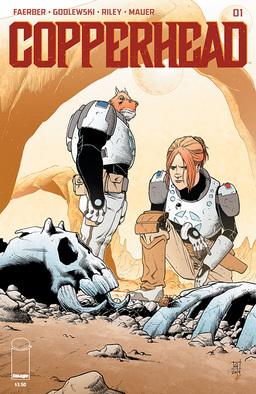 It was followed, however, by one of the strongest: C.O.W.L. by Kyle Higgins, Alec Siegel, and Rod Reis. C.O.W.L. has a Watchmen-like vibe; it opens in 1962 Chicago, where a Russian supervillain named Skylancer fails in his attempt to assassinate a city Alderman. Four members of C.O.W.L, a team of superpowered individuals, fail to even slow him down, and he takes his anger out on dozens of civilians on State Street in the heart of the city, slaughtering them. Working in concert, the last two members of the squad manage to kill him. Hours later an investigative team, following up on a tip, tracks down Skylancer’s weapons cache, and the leader of the team, the secretive John Pierce, finds a surprising classified file that reveals that not is as it seems. C.O.W.L. is drenched with 60’s Chicago politics, the jargon of street cops, and Rod Reis’s gorgeous painted art. There’s clearly a lot more going on here than meets the eye, and I want to know what it is.
It was followed, however, by one of the strongest: C.O.W.L. by Kyle Higgins, Alec Siegel, and Rod Reis. C.O.W.L. has a Watchmen-like vibe; it opens in 1962 Chicago, where a Russian supervillain named Skylancer fails in his attempt to assassinate a city Alderman. Four members of C.O.W.L, a team of superpowered individuals, fail to even slow him down, and he takes his anger out on dozens of civilians on State Street in the heart of the city, slaughtering them. Working in concert, the last two members of the squad manage to kill him. Hours later an investigative team, following up on a tip, tracks down Skylancer’s weapons cache, and the leader of the team, the secretive John Pierce, finds a surprising classified file that reveals that not is as it seems. C.O.W.L. is drenched with 60’s Chicago politics, the jargon of street cops, and Rod Reis’s gorgeous painted art. There’s clearly a lot more going on here than meets the eye, and I want to know what it is.
In addition to the nine complete issues mentioned above, the book also contains covers and editorial matter, and lots of delicious ads for other Image comics, like the intriguing Graveyard Shift, Rumble, Nameless, Copperhead, and Surface.
Image Firsts Compendium was clearly a risk for Image Comics — they’re certainly losing money on every copy they sell. But it’s already paid off in my case: I’ll be picking up trade paperback collections of C.O.W.L, The Fade Out, and Southern Bastards when I visit the comic shop again, and I’m thinking seriously about Nailbiter and Low as well. I find it surprising that I was drawn to the compendium by the promise of the latest horror and fantasy comics, and ended up most impressed by the crime and superhero tales. Go figure.
If you have even the slightest interest in keeping up with what’s going on in modern comics, this book could well be the best investment you make all year.
Image Firsts Compendium is not currently available through Amazon.com or Barnes & Noble, but you can find a copy in most comic shops. Free Comic Day is coming up on the first Saturday in May — if you’re thinking about a visit to your local comic shop anyway, it might be a great idea to pick up a copy.
Image Firsts Compendium, Volume One was published by Image Comics on February 11. It is 320 pages in full color, priced at a criminally low $5.99. I hope the promise in its title is borne out in future volumes. Get more details here.
See all of our recent reviews and coverage of comics here.